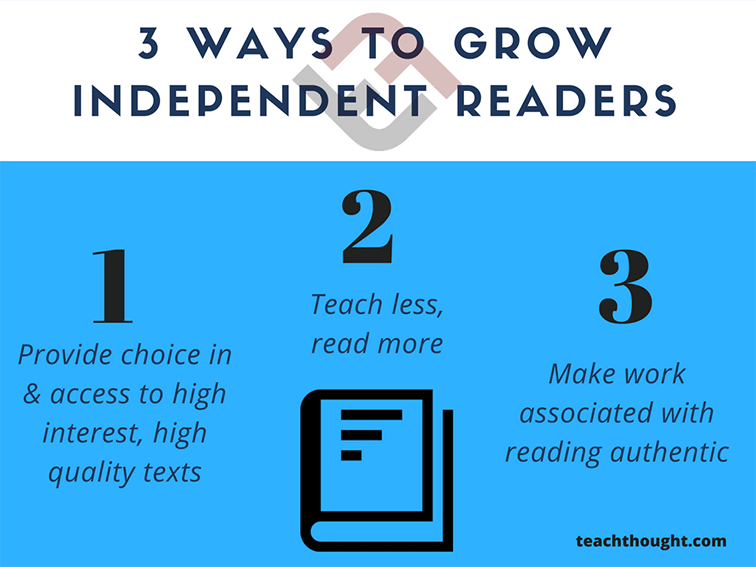
3 Easy Ways To Grow Independent Readers
by Matt Renwick
Guiding students to become self-determining learners should be the ultimate goal of any teacher. This is especially true for reading. The benefits that come with being a lifelong reader are plenty.
For starters, lifelong readers tend to make more money. A study from Italy found that kids who were exposed to more books as a child, along with more opportunities to read, made on average 9 percent more income than counterparts without this access to books. Reasons for this were hard to find. Possibilities include the modeling for youth with having literature available, and the opportunities to explore one’s curiosities.
Second, adults who read literature are more likely to be able to empathize with someone else’s situation. Researchers have found that people who engage in social experiences mediated through fiction could better empathize with others’ situations. This happens because readers practice their “perspective-taking” skills when they put themselves in the shoes of the characters. This skill can transfer to a person’s life.
Most surprisingly, people who read on a regular basis may actually live longer. According to a recent study, book readers out lived their non book reader counterparts on an average of 23 months. This almost-two year difference in health benefits was reserved for book readers; newspaper and magazine connoisseurs only saw limited benefits. A possible reason is literature incites more cognition on the part of the reader. Consuming news, while important, is a one way street.
Knowing this information, one would think people would be clamoring to read more books. Unfortunately the opposite is true. In a Washington Post article, literary reading is on the decline, from 57 percent in 1982 to 43 percent in 2015. There are a variety of reasons for this, including more distractions available that can steal attention (i.e. social media), along with people’s lives becoming more steadily busy.
However, a part of the responsibility for declining recreational reading, especially with literature, can be pointed toward schools. With the advent of high stakes testing and national standards, teachers are expected to increase nonfiction reading and raise the rigor of reading assignments. This leaves little time for recreational and deep reading experiences.
These three suggestions offer possibilities to bring back a love for reading in the classroom. The outcomes can lead to lifelong, independent readers.
3 Ways To Grow Independent Readers
- Provide choice in and access to high interest, high quality texts.
This goes beyond a stacked school library or having a full-time librarian on staff (both of which are important). Classrooms should also have a robust and organized library of texts that students can check out any time of the day.
This might mean an annual budget to update the classroom library. New titles are published every year. They may not be exposed to them without a teacher who is knowledgeable and willing to spend time promoting these new reading opportunities. Organizations like the Cooperative Children’s Book Center at the University of Wisconsin-Madison make it their mission to promote excellent titles for our students and teachers.
(Consider: 30 Of The Best Books To Teach Children Empathy.)
- Teach less, read more.
The district-prescribed reading programs currently mandated in many schools tend to position the teacher as the disseminator of strategies and skills. While this makes sense in theory, the reality is that every student becomes a better reader through their very personal reading experiences. When we read something engaging, especially with fiction, we mentally and emotionally reside in the characters and situations. If students are not invested in the text, no amount of strategy or skill instruction will suffice. Engagement is often a prerequisite for achievement.
In response, teachers should keep their demonstrations to a minimum. Model what needs to be conveyed, and release the responsibility for reading to the students when ready. For every minute spent “teaching” a skill or strategy is the same amount of time lost for students to apply them in context. To provide the necessary scaffolding for applying reading strategies and skills, use interactive practices such as shared read aloud and partner reading.
These activities should be temporary, as the ultimate goal is students reading independently with purpose.
- Make work associated with reading authentic.
If the activities we ask students to do related to their reading do not resemble what readers might do in the real world, we should question it. To promote reading as a lifelong endeavor starts with replicating the habits of real readers. This includes keeping track of the books we read, but avoiding having students respond to comprehension questions once they are done reading every chapter.
No lifelong reader does the latter voluntarily. Instead, teachers can individually conference with students about their current reading. This more personal assessment opportunity can reveal what they understand about their current choice in text, as well as what they will be reading next.
Above all, remember why people do anything at all over and over: for the reward of the experience. Whether that be for entertainment, to learn, or a mix of both, readers come back to read and read again because they gain something from it. That means teachers have to remind their students continuously why they engage in reading in their classrooms. It can be a personal reason that is individual to each student.
The teacher’s goal is to foster that purpose within each student and help them develop reading as a habit for a lifetime. Their lives and livelihoods may depend on it.
To learn more about this topic, download his free eBook, The Secrets of Self-Directed Student Learning. Matt Renwick is an elementary school principal in Mineral Point, Wisconsin and author of multiple books, including 5 Myths About Classroom Technology: How do we integrate digital tools to truly enhance learning? (ASCD, 2015) and The Secrets of Self-Directed Student Learning. Learn more about Matt on his website, mattrenwick.com, and by following him on Twitter @ReadByExample.
3 Ways To Grow More Independent Readers
